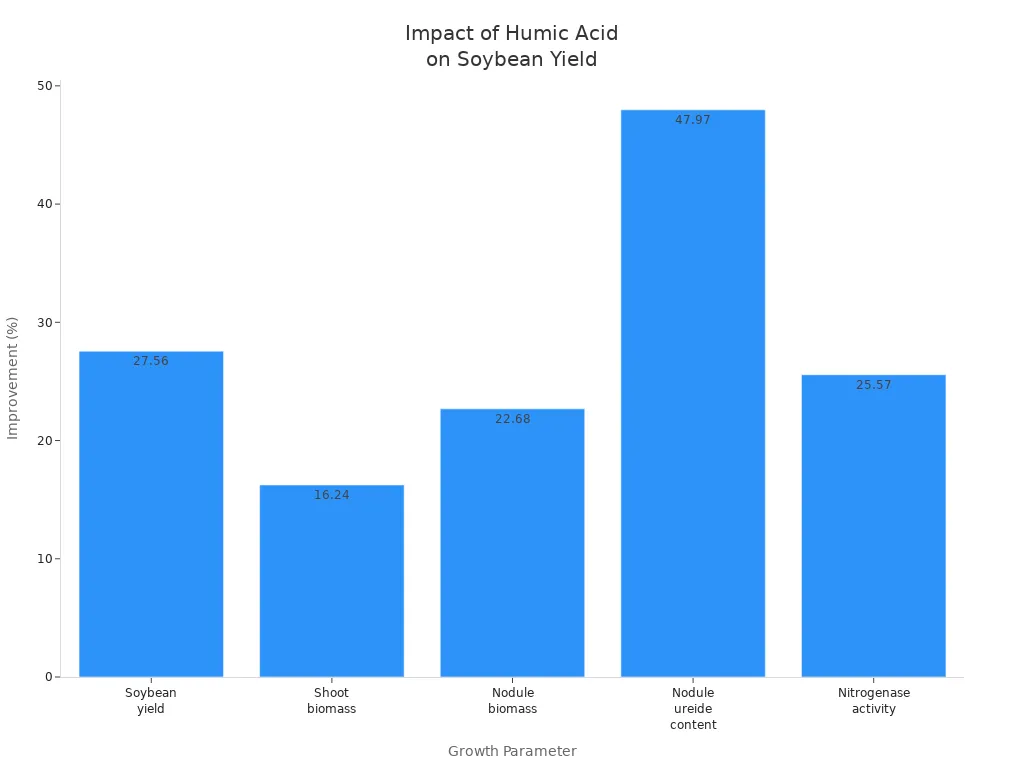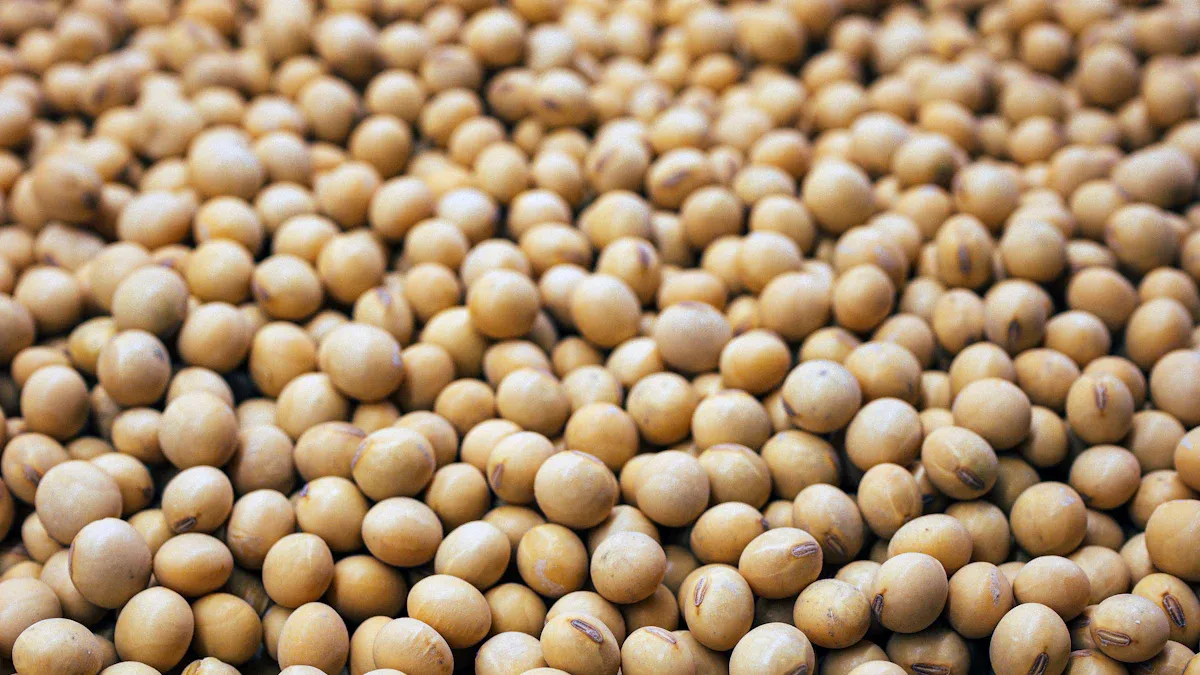Why Humic Acid Fertilizer Boosts Soybean Growth and Yield

You can see big changes in how soybeans grow and how much they produce when you use humic acid fertilizer. This fertilizer helps plants take in more nutrients. It makes the soil better for growing. It also helps plant hormones work better. Plants become stronger against stress. Scientists and farmers have tested these effects. The results show these benefits are real. For example, soybeans with humic acid fertilizer give 27.56% more yield than regular fertilizers.
Parameter | Improvement |
|---|---|
Soybean yield | +27.56 |
Shoot biomass | +16.24 |
Nodule biomass | +22.68 |
Nodule ureide content | +47.97 |
Nitrogenase activity | +25.57 |

Results from real fields are the same as lab tests. This proves humic acid fertilizer for soybean works well in real life.
Key Takeaways
Humic acid fertilizer helps soybeans grow strong roots and more nodules. This lets the plants take in more water and nutrients.
Using humic acid makes the soil loose and airy. This helps roots grow deep and healthy.
Humic acid helps soybean plants take in nutrients like nitrogen, iron, and magnesium.
When you use humic acid, soybeans use nitrogen better. This means you do not need as much chemical fertilizer.
Humic acid helps good microbes and enzymes in the soil. These make it easier for soybeans to get nutrients.
This fertilizer helps soybeans fight drought and diseases. It makes plants stronger and helps them keep water.
Use humic acid at important growth times like V2, V6, and R2. This gives the best yield, even when it is hot or dry.
Change how much humic acid you use based on your soil. Always test a small area first for the best results.
Humic Acid Fertilizer for Soybean
What Is Humic Acid
Humic acid forms when plants and animals break down in soil. You can find it in things like compost and peat. Using humic acid fertilizer helps soybeans grow better and make more beans. This fertilizer is a biostimulant. It helps soybeans use water and nutrients well.
There are different kinds of humic acid fertilizer for soybean. Many farmers mix humic acid with other fertilizers to get the best results. Here are some common types:
Vermicompost and livestock manure give nutrients like nitrogen, phosphorus, and potassium. They also have organic acids that help soybeans take in nutrients.
Humic acid blends mix humic acid with chemical fertilizers. These blends help plants use fertilizer better and grow strong.
Standalone humic acid has only humic acid. You can use it as a supplement or instead of regular fertilizer.
Using these types helps farmers use less chemical fertilizer and farm in a better way.
How It Works
Humic acid fertilizer helps soybeans in many ways. The chemical structure of humic acid is important. When you use organic fertilizers for a long time, humic acid in the soil gets more aliphatic carbon. This makes humic acid more stable and protects soil clumps. Stable soil clumps make soil better for growing. Soybeans can get more water and nutrients.
Humic acid acts like glue in the soil. It sticks soil pieces together to make bigger clumps called macroaggregates. These clumps keep soil loose and airy. Roots can grow deeper and stronger. More organic carbon in soil means soybeans get more nutrients.
Humic acid also helps roots in other ways. It sticks to soybean roots and causes more root hairs and side roots to grow. This helps plants take in more water and nutrients. Humic acid also makes some root enzymes work better.
Water-soluble humic acid does even more. It helps soybeans make more nodules by helping good bacteria in the soil. These nodules take nitrogen from the air and give it to the plant. This helps soybeans grow faster and make more beans.
Tip: Pick a humic acid fertilizer that fits your soil and crop. You can mix it with organic or chemical fertilizers for the best results.
Nutrient Absorption
Micronutrient Uptake
You want your soybean plants to get enough nutrients. Micronutrients like magnesium, iron, and manganese are very important for plant health. Humic acid fertilizer helps soybeans take in these nutrients more easily. Studies show that spraying humic acid on leaves helps soybeans get more magnesium, iron, and manganese. Your plants also take in more nitrogen, phosphorus, potassium, calcium, sodium, copper, and zinc. This better nutrient absorption happens even if the soil is not great or water is low. Because of this, your soybeans grow stronger and healthier.
Note: When soybeans get more micronutrients, they can handle stress better and grow well, even when things are tough.
Nitrogen Use Efficiency
Nitrogen helps soybeans grow fast and make more beans. But not all the nitrogen you put in the soil is used by the plant. Humic acid fertilizer helps soybeans use nitrogen better. It helps roots take up more nitrogen from the soil. When you use humic acid, your plants turn more nitrogen into growth and beans. This means you can use less fertilizer and still get good results. You save money and help the earth at the same time.
Here is a quick look at how humic acid changes nitrogen use:
Treatment | Nitrogen Uptake | Yield Increase |
|---|---|---|
No humic acid | Low | Low |
Humic acid applied | High | High |
Root Development
Healthy roots help soybeans reach water and nutrients deep in the soil. Humic acid fertilizer makes roots grow longer and have more side branches. You will see more root hairs and nodules on your plants. These nodules help soybeans get nitrogen from the air, which helps them grow even more. Strong roots also help plants stand up to dry weather and other problems. When you use humic acid, you help your soybeans grow deep, healthy roots.
Tip: Strong roots help soybeans keep growing, even when the weather is dry or the soil is not perfect.
Soil Health

Soil Structure
You want your soybean fields to have good soil. Humic acid fertilizer helps make the soil stronger. When you add humic acid, the soil holds together better. This makes bigger clumps in the soil called aggregates. These clumps keep the soil loose and full of air. Soybean roots can grow deeper and spread out more.
Humic acid also helps the soil’s chemistry. It raises the amount of phosphorus and other nutrients. Over time, the soil gets more fertile and plants get stronger. Even sandy soils get better when humic acid is mixed with bentonite. The soil holds more water and nutrients. Your soybeans get what they need, even when it is dry.
Here is a table that shows how humic acid changes soil and plants:
Effect on Soil and Plants | Description |
|---|---|
Nutrient Absorption | Humic acid fertilizers help soybeans take in more nitrogen (N), sulfur (S), and magnesium (Mg). |
Soil Chemical Attributes | Phosphorus in the soil goes up after using humic substances. |
Soil Fertility | Using humic acid for a long time makes the soil more fertile. |
Plant Growth and Yield | Better nutrient use and soil fertility help plants grow well over time. |
Tip: Good soil structure helps soybeans fight compaction and lets roots find water and nutrients easily.
Microbial Activity
Soil microbes help soybeans grow well. Humic acid is food for these microbes. When you use humic acid, you get more helpful bacteria in the soil. These microbes break down old plant parts and give nutrients to soybeans.
Humic acid also makes soil enzymes work better. These enzymes turn nutrients into forms plants can use. You see more sucrase, urease, and phosphatase in your fields. This gives soybeans more nitrogen, phosphorus, and potassium.
Parameter | Effect of Biochar-Humic Acid Carrier with Microbial Consortium on Soybean Soil |
|---|---|
Soil Enzyme Activities | More sucrase, urease, alkaline phosphatase, and catalase activity |
Nutrient Availability | More ammonium, nitrate nitrogen, inorganic phosphorus, and quick potassium |
Soybean Growth Parameters | Plants are taller, stems are thicker, and dry weight is higher |
Microbial Colonization | Bacillus spp. and Sinorhizobium meliloti grow well and fill the soil |
Note: Helping soil microbes makes soybeans stronger and healthier.
pH Balance
Soil pH changes how soybeans use nutrients. If soil is too acidic, soybeans have trouble. Humic acid helps balance the pH. It raises the pH in acidic soils and makes them better for soybeans.
Humic acid also improves other soil parts. You get more organic carbon and better cation exchange capacity. There is more calcium and sulfur in the soil. These changes help soybeans take in more phosphorus. Phosphorus is important for growth and yield. Some farmers use humic acid with gypsum to help soybeans get more phosphorus and lower soil sodicity.
Tip: Balanced soil pH helps soybeans use nutrients better. This means better growth and higher yields.
Plant Growth and Hormones
Auxin and Cytokinin
You want your soybeans to grow strong and healthy. Humic acid fertilizer helps with this by affecting two plant hormones: auxin and cytokinin. These hormones control how plants grow, make roots, and form shoots. When you use humic acid, you do more than add nutrients. You help soybeans make more of their own growth hormones. Scientists found that humic acid turns on plant pathways that make auxin and cytokinin. In tests with wheat and Arabidopsis, humic acid made genes for these hormones work harder. This lets soybeans grow faster and make better roots and shoots. Auxin helps soybeans grow longer roots and more root hairs. Cytokinin helps new shoots and leaves grow. Humic acid does not give these hormones to the plant. It helps the plant make more of them by itself. This makes plants stronger and healthier. They can take in more water and nutrients. You can see these changes in your field. Soybeans with humic acid have thicker stems, more leaves, and deeper roots. These changes help plants handle stress and make more beans.
Tip: Using humic acid helps soybeans balance their hormone levels. This balance helps plants grow better and make more beans.
Enzymatic Activity
Enzymes are important for how soybeans grow and use nutrients. Humic acid fertilizer makes these enzymes work better in plants and soil. These enzymes break down nutrients so soybeans can use them. When you use humic acid, enzymes like sucrase, urease, and phosphatase work harder. These enzymes help soybeans get more nitrogen, phosphorus, and potassium from the soil. This helps soybeans grow faster and stay healthy. Here is a table that shows how humic acid changes enzyme activity:
Enzyme | Function in Soybean Growth | Effect of Humic Acid |
|---|---|---|
Sucrase | Breaks down sugars for energy | Higher activity |
Urease | Converts urea to usable nitrogen | Higher activity |
Phosphatase | Releases phosphorus for growth | Higher activity |
Humic acid also helps soil microbes. These microbes make enzymes that give nutrients to soybeans. With more enzyme activity, soybeans can take in more nutrients and grow stronger.
Note: When enzymes work well, soybeans use nutrients better. This means healthier plants and bigger harvests.
Stress Resistance
Drought Tolerance
You want your soybeans to live through dry times. Humic acid fertilizer helps them handle drought better. When you use humic acid, soybeans keep more water in their leaves and roots. This helps plants stay healthy when there is little rain. Humic acid also makes roots grow deeper. Deeper roots can find more water. You will see more nodules on the roots. Nodules help soybeans get nitrogen from the air. These changes make soybeans stronger during dry weather.
Scientists tested humic acid on beans and maize. These crops are like soybeans. They found that plants with humic acid and good bacteria grew better. They also made more grain, even in poor soil and dry weather. The table below shows what they learned:
Evidence Aspect | Description |
|---|---|
Crop studied | Common beans and maize (legume crops like soybean) |
Treatment | Humic acid-like substances with plant growth-promoting bacteria |
Physiological effects | Higher water content, more nodules, stronger enzyme activity |
Drought recovery | Faster recovery after water stress |
Yield impact | Grain yield increased by up to 65% with combined application |
Soil conditions | Tested in low and medium fertility soils |
Drought relevance | Yield boost more pronounced under drought |
Application method | Foliar spray at key growth stages |
Environmental benefit | More root biomass left in soil, improving soil organic matter |
You can use biofertilizers with humic acid for even better results. These have good bacteria like Bradyrhizobium japonicum and arbuscular mycorrhizal fungi. They help soybeans grow well when water is low. Here are some ways these biofertilizers help:
They add more good bacteria around the roots.
They help roots take in more phosphorus and make more growth hormones.
They boost antioxidant enzymes that protect plants from drought.
They lower stress chemicals in soybeans, so plants stay healthy.
They help roots and nodules grow, so plants find water and nutrients.
Tip: Spray humic acid fertilizer on leaves during important growth times for the best drought protection.
Disease Protection
You want your soybeans to fight off diseases that hurt yield. Humic acid fertilizer helps plants stop bad fungi and bacteria. When you use humic acid, you make the soil healthier. Good microbes grow stronger, and bad ones have less chance to attack. Humic acid also makes plant cell walls thicker. This gives soybeans a natural shield against disease.
Humic acid helps enzymes that protect plants work better. These enzymes break down toxins and stop infections from spreading. Soybeans can heal faster if they get sick. You will see fewer leaf spots, root rot, and other soybean diseases.
Healthy roots and strong plants help soybeans recover from stress. You get more pods and higher yields, even when there is disease. Using humic acid in your fertilizer plan helps you grow stronger soybeans.
Note: Strong disease resistance starts with healthy soil and plants. Humic acid fertilizer gives soybeans what they need to stay healthy all season.
Yield and Quality

Seed Yield
You want your soybeans to make lots of seeds. Humic acid fertilizer can help with this. It works best when plants face hard times, like drought or heat. In Iowa, tests showed humic acid helped soybeans make more seeds. Farmers used it at V2, V6, and R2 growth stages. The biggest gains happened when there was little rain or it was hot. Humic acid gives plants a better chance to do well in bad weather. The amount of extra seeds depends on your field and climate. But you can expect better results when plants are stressed.
Tip: Use humic acid early and in the middle of growth. This helps soybeans make more seeds, especially if dry or hot weather is coming.
Oil and Protein Content
Soybean quality means how much oil and protein the beans have. You want beans that are good for selling. Studies show humic acid does not change oil in seeds. Sometimes, protein might go down a little, but this depends on the weather. Most of the time, oil and protein stay about the same with humic acid. The main benefit is more seeds and a bigger harvest, not changes in seed makeup.
Here is a quick summary:
Quality Trait | Effect of Humic Acid Fertilizer |
|---|---|
Oil Content | No big change |
Protein Content | No big change |
Seed Yield | Usually goes up |
Note: Focus on getting more seeds. Oil and protein usually stay normal.
Pod Number
The number of pods on each plant is important for your harvest. Humic acid helps soybeans grow more pods. In Kurdistan, spraying humic acid at up to 6 g/L gave the most pods. You get more pods if you use the right amount at the right time. In Afghanistan, farmers used less chemical fertilizer and added humic acid. They still got more pods per plant. This means you can use less chemical fertilizer if you add humic acid.
Spraying at the right time makes more pods.
Mixing humic acid with other fertilizers works even better.
More pods mean more seeds and a bigger harvest.
Remember: More pods per plant means a bigger harvest. Humic acid helps you get there with easy changes to your fertilizer plan.
Application Best Practices
Timing
You should use humic acid fertilizer at the right time for soybeans. Early use during the vegetative stage helps roots get strong. Many farmers see good results at V2, V6, and R2 stages. These are important times because soybeans need more nutrients and water. Using humic acid then helps roots grow and take in more nutrients. If dry or tough weather is coming, early and mid-season use helps soybeans handle stress. Think about when you plant your soybeans. Studies show planting in mid-May and using humic acid early gives more beans.
Tip: Use humic acid before or during key growth times, especially if you think drought or heat will happen.
Methods
There are different ways to use humic acid fertilizer for soybeans. Soil application is good for better soil and root growth. You can mix humic acid into the soil before planting. You can also put it on the side of plants during early growth. This helps soybeans get more nutrients and have healthy roots.
Foliar application is another way. You spray humic acid on the leaves. Spraying 6 grams per liter gives more pods, heavier beans, and higher yield. Foliar sprays work best during flowering and podding. This helps plants get nutrients fast, even if the soil is dry or hard.
Mixing humic acid with other fertilizers like NPK or sulfur works even better. You can also mix it with water hyacinth compost or other organics. This helps both the soil and the plants. Many farmers get more beans when they use humic acid with nitrogen and phosphorus.
Note: Pick the method that matches your field and tools. Both soil and foliar use can help soybeans grow better.
Dosage
You need the right amount of humic acid for the best results. Too little does not help, and too much wastes money. For foliar sprays, 6 grams per liter works best. This amount gives more pods and heavier beans without hurting plants. For soil, follow the label or ask an expert. Most products say to use 5 to 10 kilograms per hectare for soil. If you mix humic acid with other fertilizers, change the amount to fit your crop and soil.
Always test a small area first if you try something new. Watch your soybeans and change the rate if you need to. The right dosage helps you get the most from humic acid fertilizer for soybeans.
Tip: Start with the suggested rate and change it if needed. The right amount saves money and gives more beans.
Soil Types
You need to match your humic acid fertilizer plan to your soil type. Each soil has unique needs. When you understand your field, you get better results from humic acid.
1. Sandy Soils
Sandy soils drain water quickly. They often lose nutrients fast. Humic acid helps sandy soils hold water and nutrients longer. You should apply humic acid with organic matter or compost. This mix improves soil structure and keeps roots moist. Use soil application for best results. Foliar sprays help too, but soil treatment gives longer-lasting benefits.
2. Clay Soils
Clay soils hold water but can get hard and compacted. Roots may struggle to grow deep. Humic acid breaks up clay particles and makes the soil looser. You see better root growth and more air in the soil. Apply humic acid before planting and during early growth. This helps roots spread out and take in more nutrients.
3. Loam Soils
Loam soils have a good mix of sand, silt, and clay. They drain well and hold nutrients. Humic acid still helps by boosting microbial activity and nutrient uptake. You can use lower rates of humic acid here. Both soil and foliar applications work well.
4. Saline or Sodic Soils
Saline soils have too much salt. Sodic soils have too much sodium. Both can hurt soybean growth. Humic acid binds salts and lowers their effect on roots. You should combine humic acid with gypsum or sulfur fertilizers. This helps fix the soil and lets soybeans grow better.
5. Acidic Soils
Acidic soils make it hard for soybeans to get nutrients. Humic acid raises soil pH and improves nutrient availability. You can use humic acid with lime for even better results. Apply before planting for the best effect.
Soil Type | Humic Acid Benefit | Application Tip |
|---|---|---|
Sandy | Holds water, keeps nutrients | Mix with compost, use soil application |
Clay | Loosens soil, aids root growth | Apply before planting, early growth |
Loam | Boosts microbes, aids uptake | Use lower rates, any method |
Saline/Sodic | Binds salts, protects roots | Combine with gypsum or sulfur |
Acidic | Raises pH, improves nutrients | Use with lime, apply before planting |
Tip: Always test your soil before you start. Soil tests show pH, salt levels, and texture. This helps you pick the right humic acid plan.
You can adjust your humic acid use as your soil changes. Watch your soybeans and soil each season. Change your plan if you see problems. With the right approach, you help your soybeans grow strong in any soil.
You get lots of good things when you use humic acid fertilizer for soybean. New research shows these main benefits:
It makes roots grow strong and nodules form early.
It helps good bacteria so soybeans get more nitrogen.
It gives soybeans more iron, even in hard soils.
It lets plants deal with stress and grow better.
It helps farmers use less chemical fertilizer and farm in a better way.
Experts say you should try small tests on your own fields first. This helps you see how humic acid fertilizer for soybean works where you farm. If you make a good plan, your plants will be healthier and your harvest will be bigger.
FAQ
What is the best time to apply humic acid fertilizer to soybeans?
It is best to use humic acid early in the season. Try to apply it at V2, V6, or R2 growth stages. Early use helps roots grow and take in more nutrients. You can also put it on before planting to help the soil.
Can I mix humic acid with other fertilizers?
Yes, you can mix humic acid with NPK, sulfur, or organic fertilizers. Mixing them helps soybeans use nutrients better and grow stronger. Always read the label to make sure they work well together.
Will humic acid work in all soil types?
Humic acid helps most soils, like sandy, clay, loam, saline, and acidic soils. You might need to change how much or how you use it for your soil. Check your soil and adjust your plan if needed.
How often should I apply humic acid fertilizer?
Most farmers use humic acid one or two times each season. You can use it when planting and again when plants are young. Always follow the directions on the product for the best results.
Is humic acid fertilizer safe for the environment?
Humic acid comes from natural things in the soil. It helps you use less chemical fertilizer and keeps soil healthy. Using it the right way is good for the environment.
Can humic acid help soybeans during drought?
Yes, humic acid helps roots grow and hold more water. Soybeans can handle dry weather better and recover faster after drought.
Does humic acid increase soybean yield every year?
How much yield goes up depends on weather, soil, and how you farm. You see the biggest boost in tough years, like during drought or heat. Using humic acid often helps soil and plants stay healthy over time.
